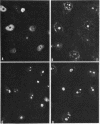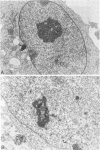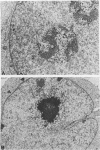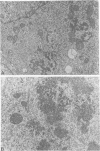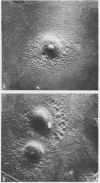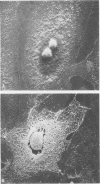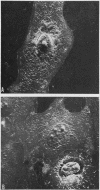Abstract
We have used immunofluorescence in parallel with transmission and scanning electron microscopy to characterize the unusual cytoplasmic and nucleolar accumulation of Simian virus 40 (SV40) virion protein (C antigen) at restrictive temperatures (39 to 41 C) in monkey cells infected with a temperature-sensitive mutant of SV40 defective in virion assembly, tsB11. Cytoplasmic and nucleolar accumulation of C antigen did not occur in wild-type-infected cells at any temperature. Wild-type- and tsBll-infected cells were not distinguishable at 33 C by immunofluorescence or electron microscopy. Temperature-shift experiments using metabolic inhibitors of DNA (cytosine arabinonucleoside, 20 μg/ml), RNA (actinomycin D, 5 μg/ml), and protein synthesis (cycloheximide, 2 × 10−4 to 10 × 10−4 M) were used to investigate the requirements for ongoing DNA, RNA, and protein synthesis in the distribution of virion protein between the nucleus, nucleolus, and cytoplasm. The transport of C antigen from the nucleolus and cytoplasm into the nucleus was complete after a temperature shift-down (41 and 39 to 33 C). Limited virus particle formation occurred after the shift-down in the presence of actinomycin D and cycloheximide, indicating some of the 39 to 41 C synthesized virion protein could be used for capsid assembly at 33 C in the absence of further virion protein synthesis. Nucleolar and cytoplasmic accumulations of C antigen occurred in the absence of drugs after a shift-up (33 to 39 C and 41 C) indicating a continuous requirement for the tsB11 mutant function. Furthermore, the virion protein synthesized at 33 C remained confined to the nucleus when the cells were shifted to 39 and 41 C in the presence of actinomycin D or cycloheximide. In the presence of cytosine arabinonucleoside, however, the virion protein accumulated in large aggregates in the nucleus and nucleolus after the shift-up, but did not migrate into the cytoplasm as it did in drug-free tsB11-infected control cells. Colchicine (10−3 M) had no effect on the abnormal accumulation of C antigen during shift-up or shift-down experiments suggesting that microtubular transport plays little if any role in the abnormal transport of tsB11 virion protein from cytoplasm to nucleus. Although virus particles were never observed by electron microscopy and V antigen was not detected by immunofluorescence at 39 or 41 C in tsB11-infected cells, dense amorphous accumulations were formed in the nucleoli and cytoplasm. We suggest that the tsB11 function is continuously required for the normal transport of SV40 virion protein between the cytoplasm, nucleolus, and nucleus and for the assembly of capsids and virions. Several possible mechanisms for the altered tsB11 function or protein are discussed. One of the virion proteins may also be involved in some presently undetermined nucleolar function during SV40 productive infection.
Full text
PDF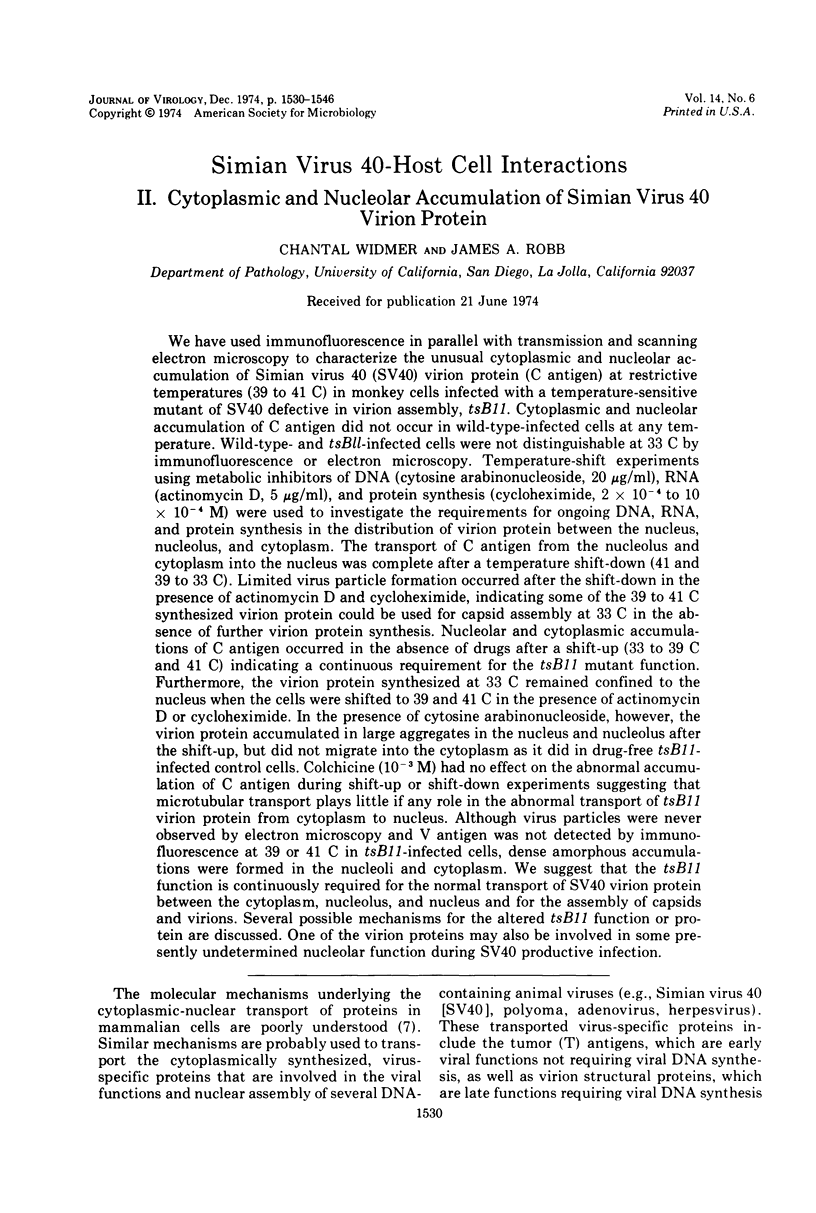
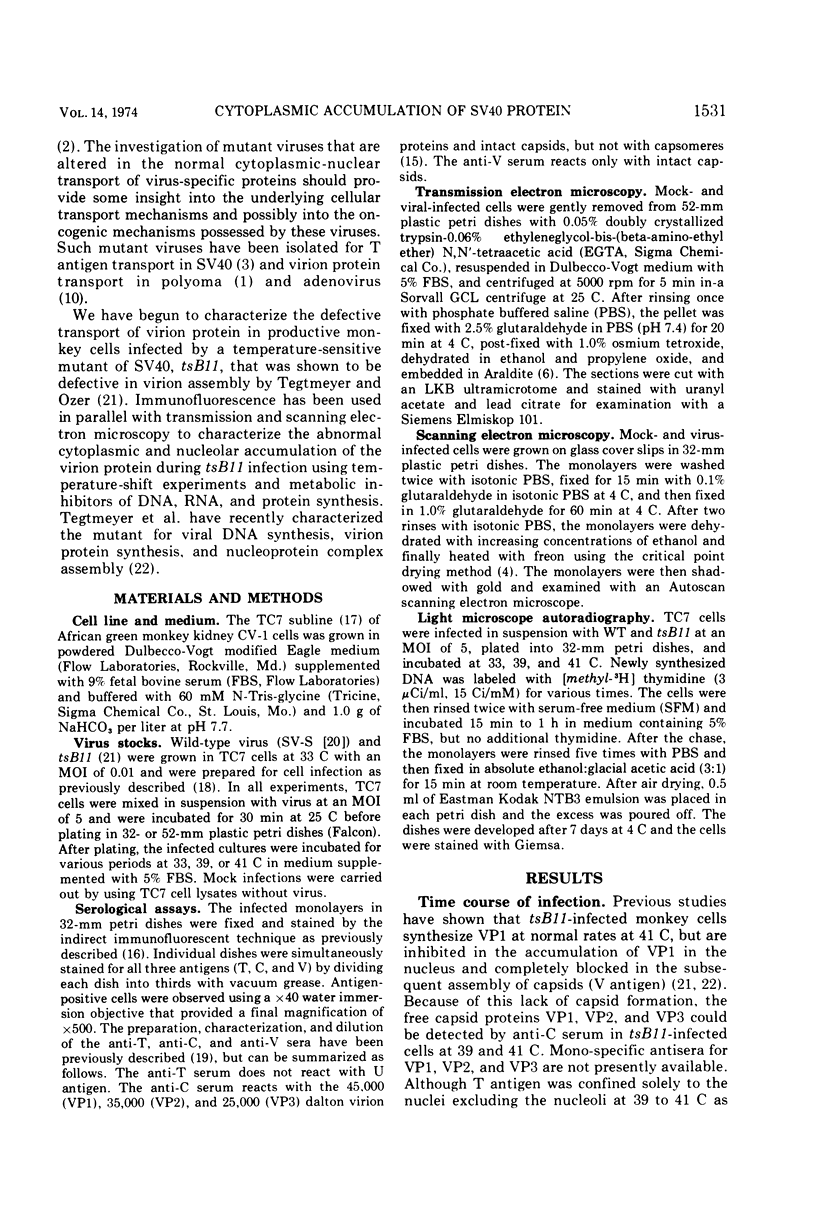
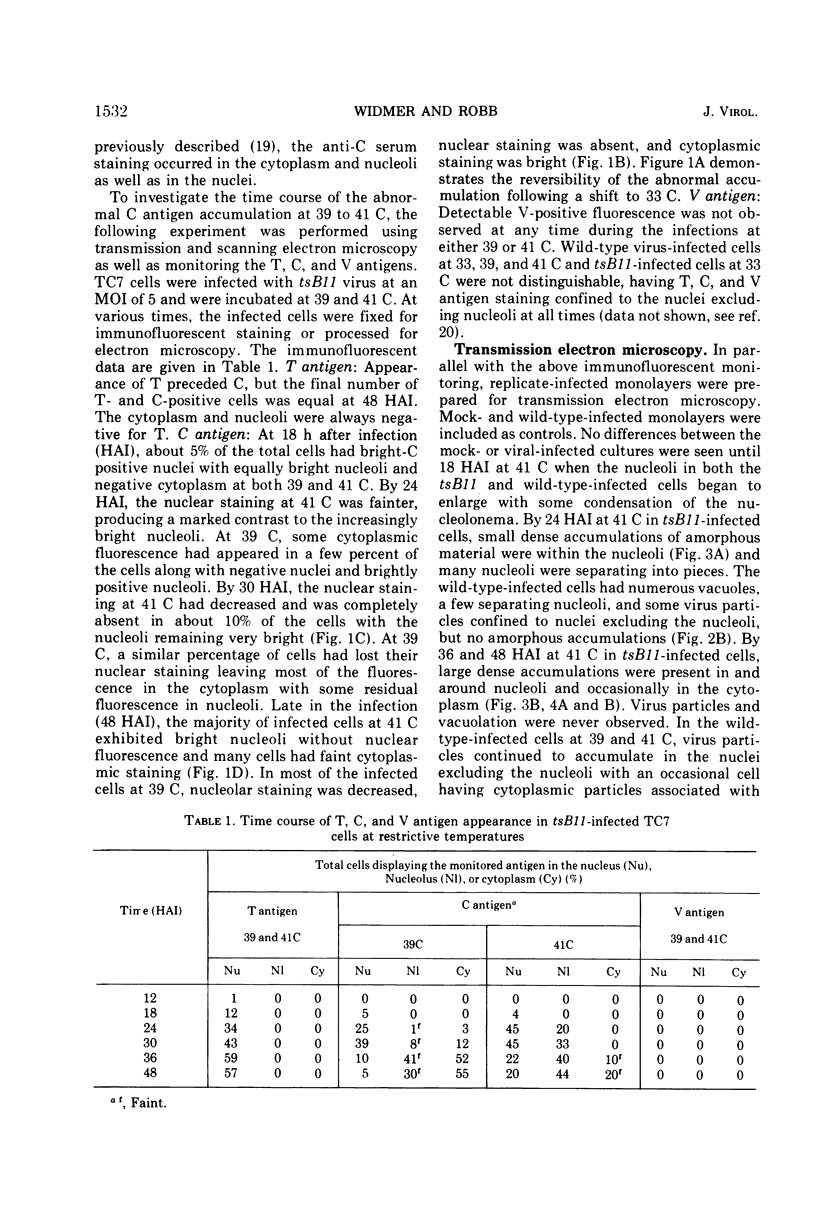
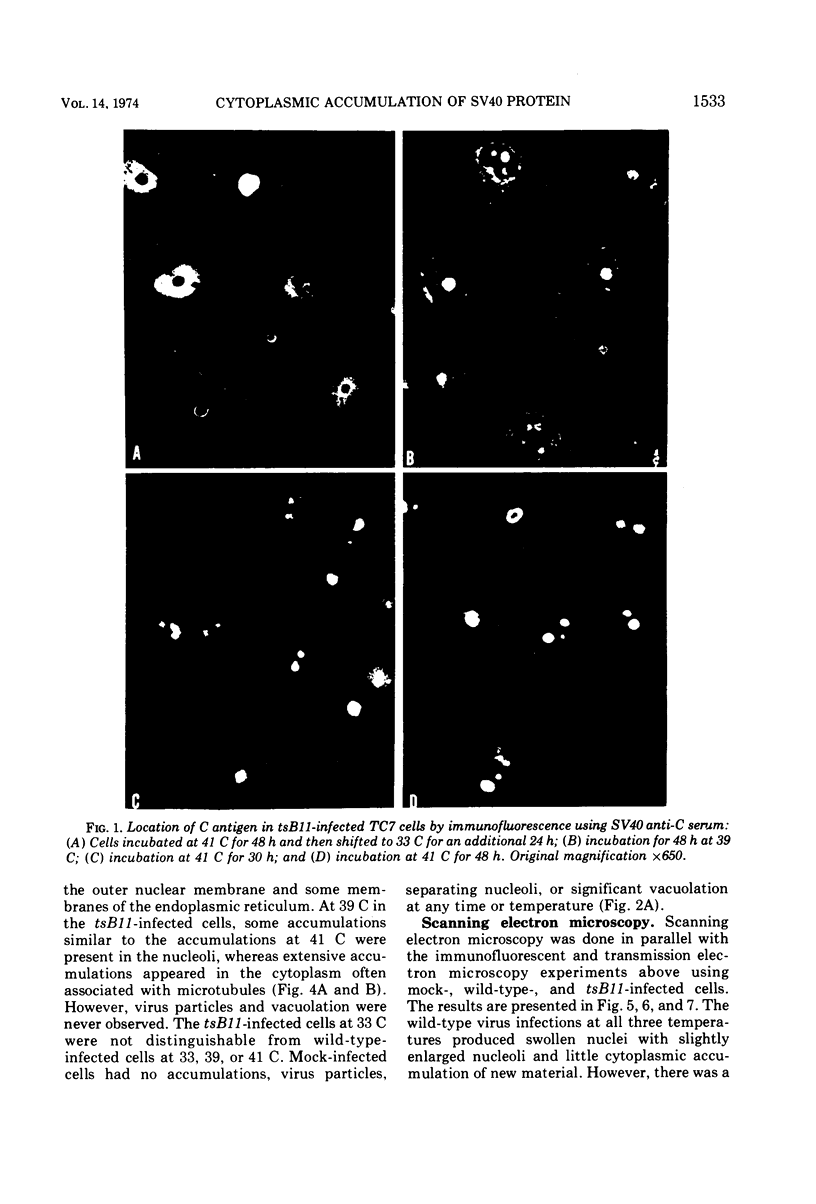
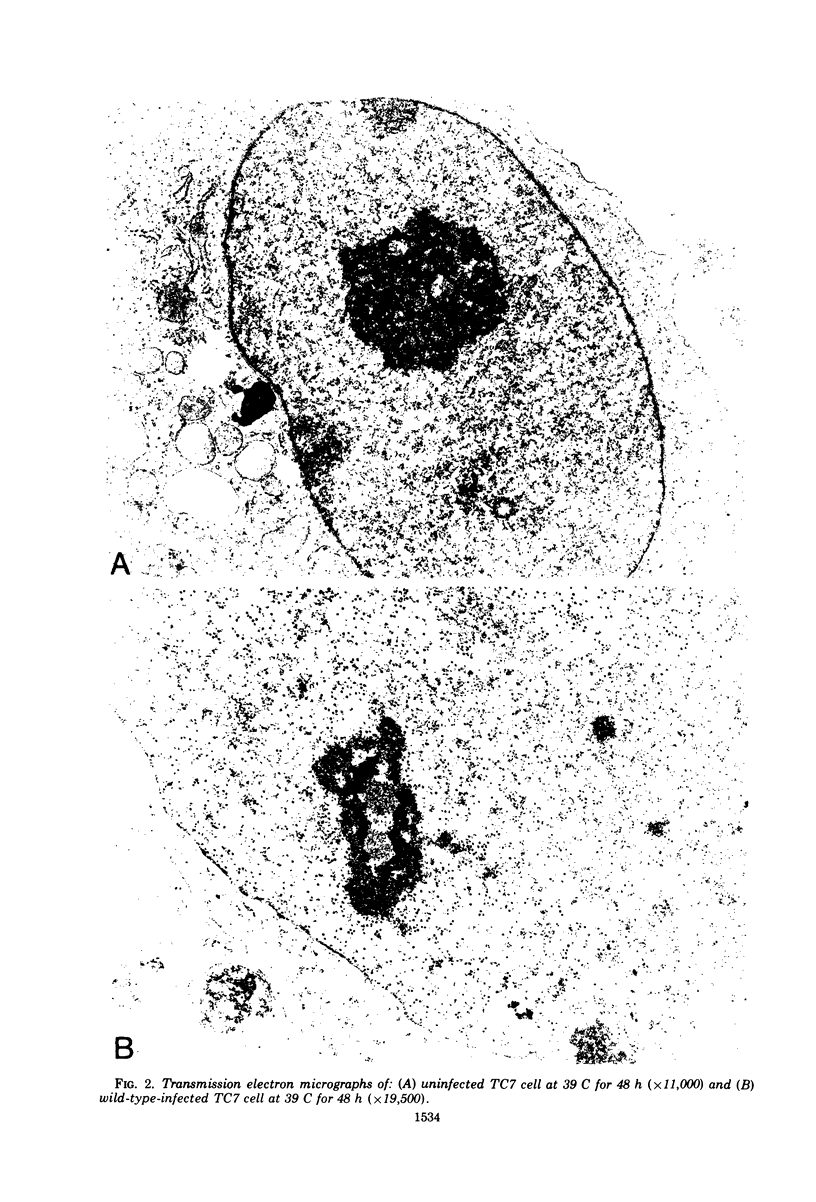
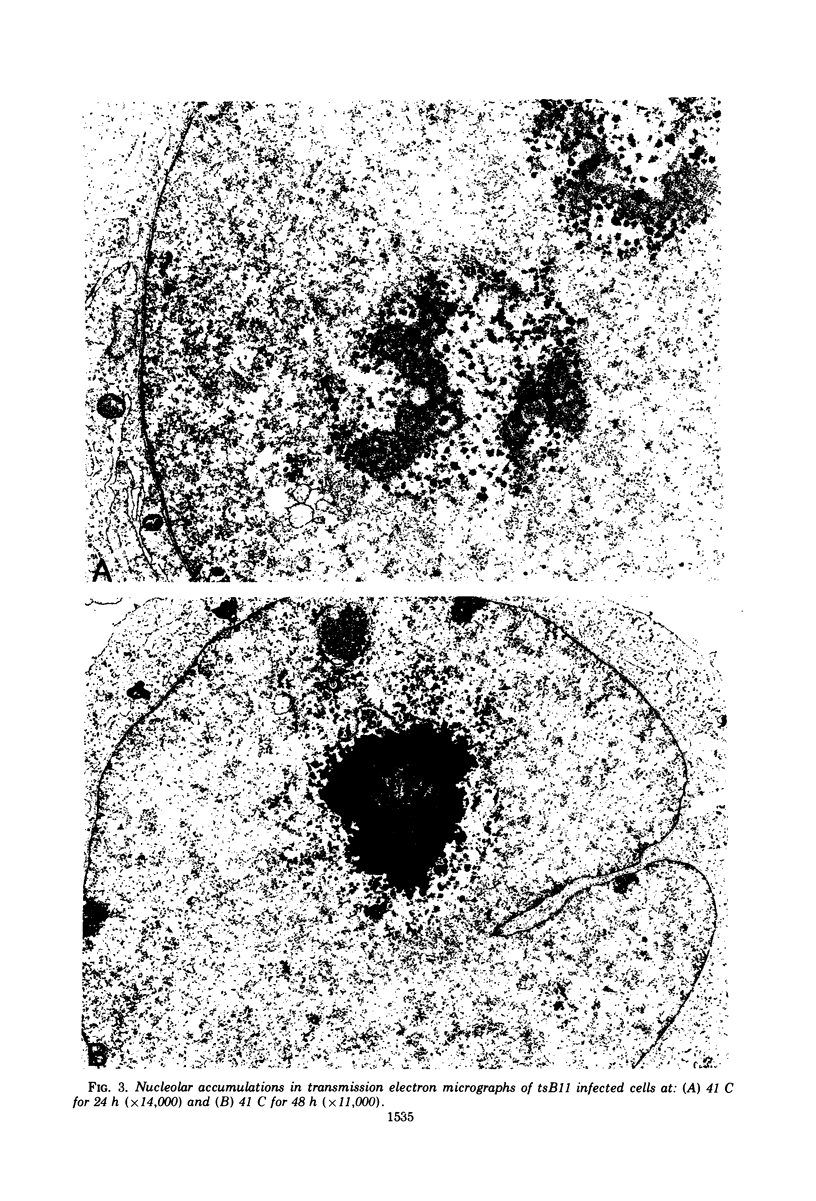
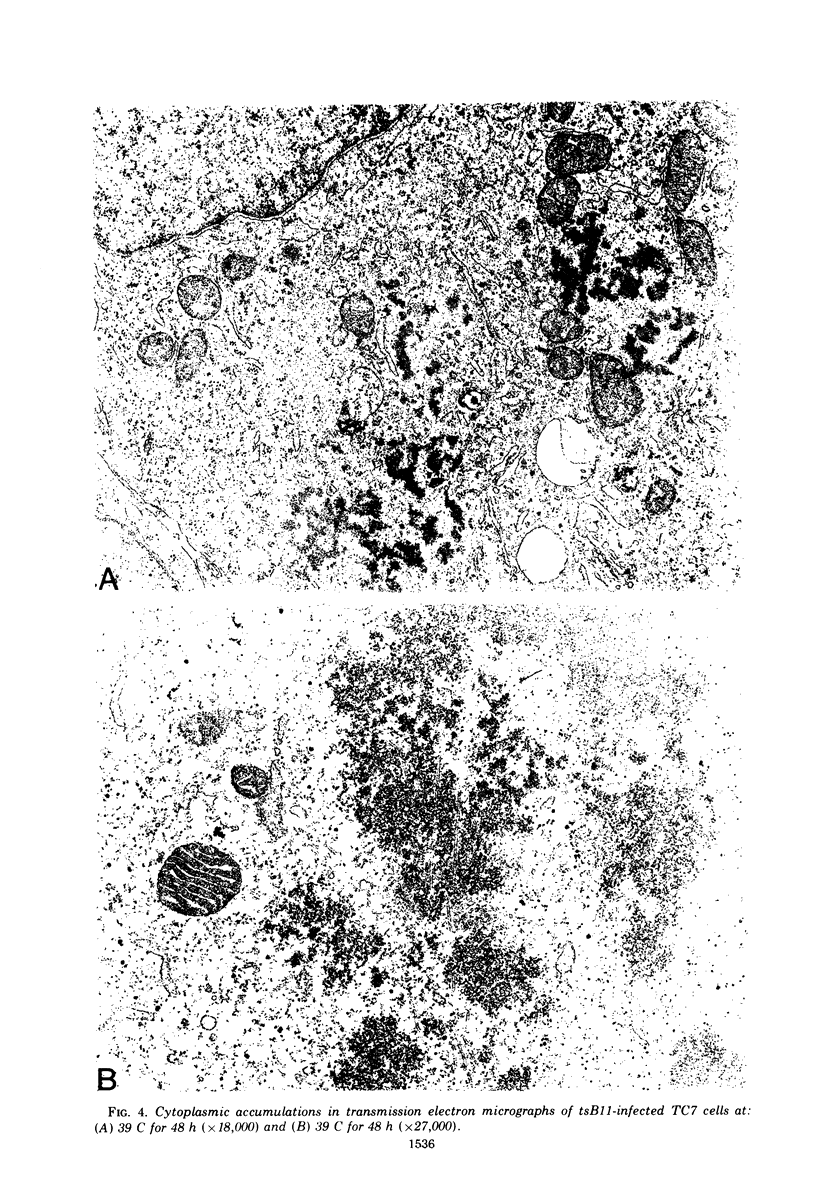
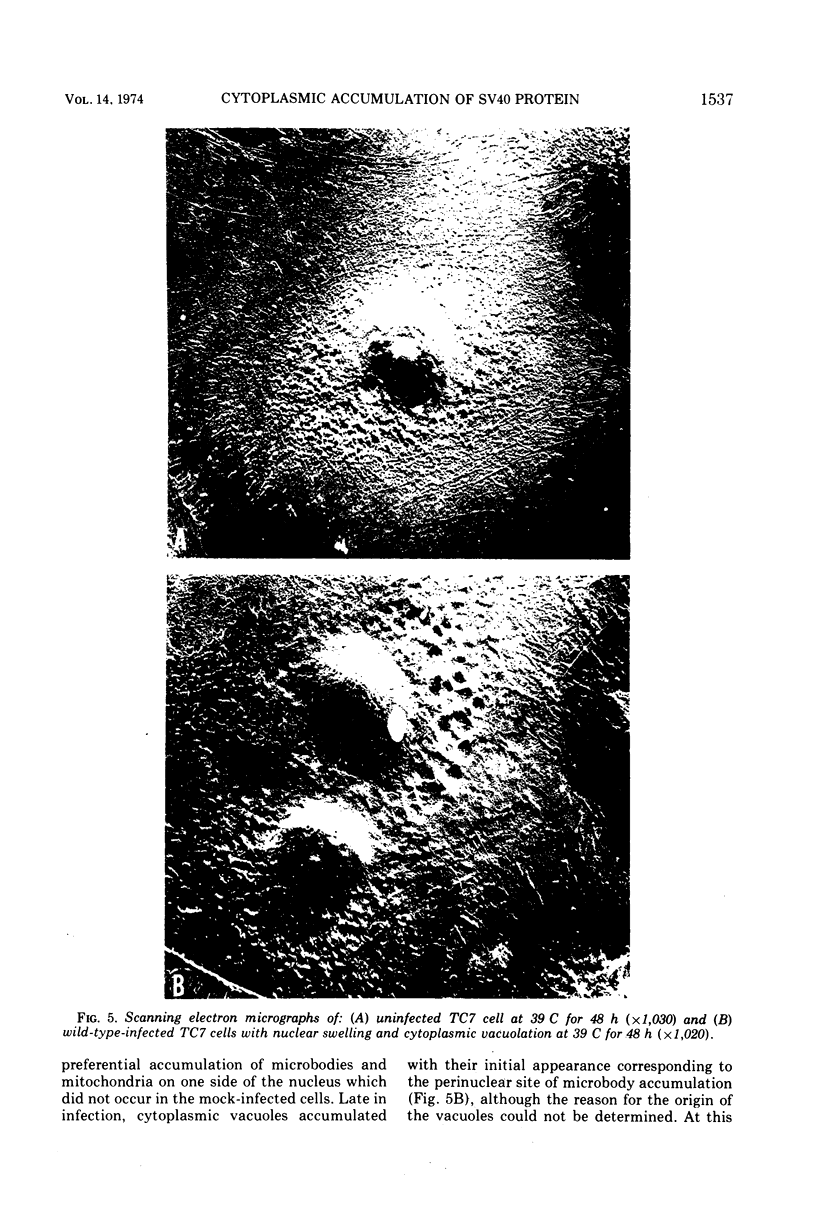
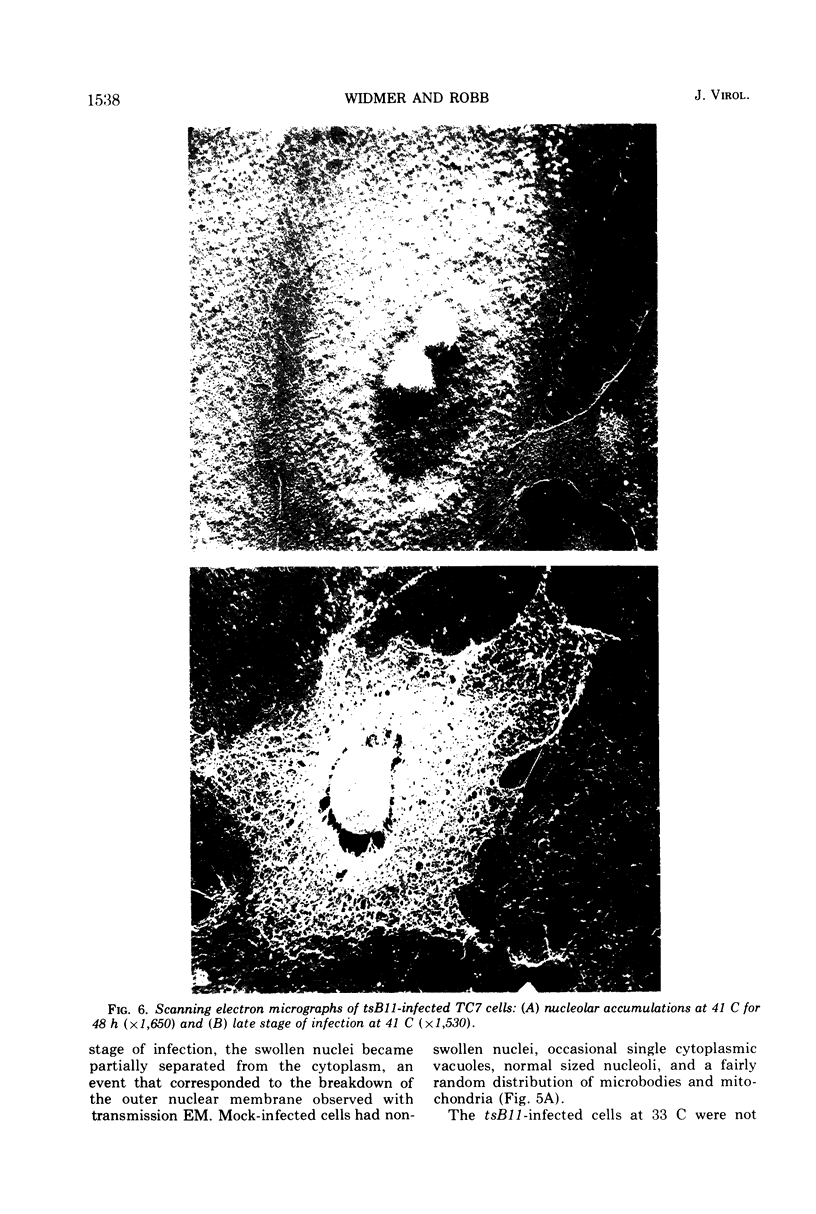
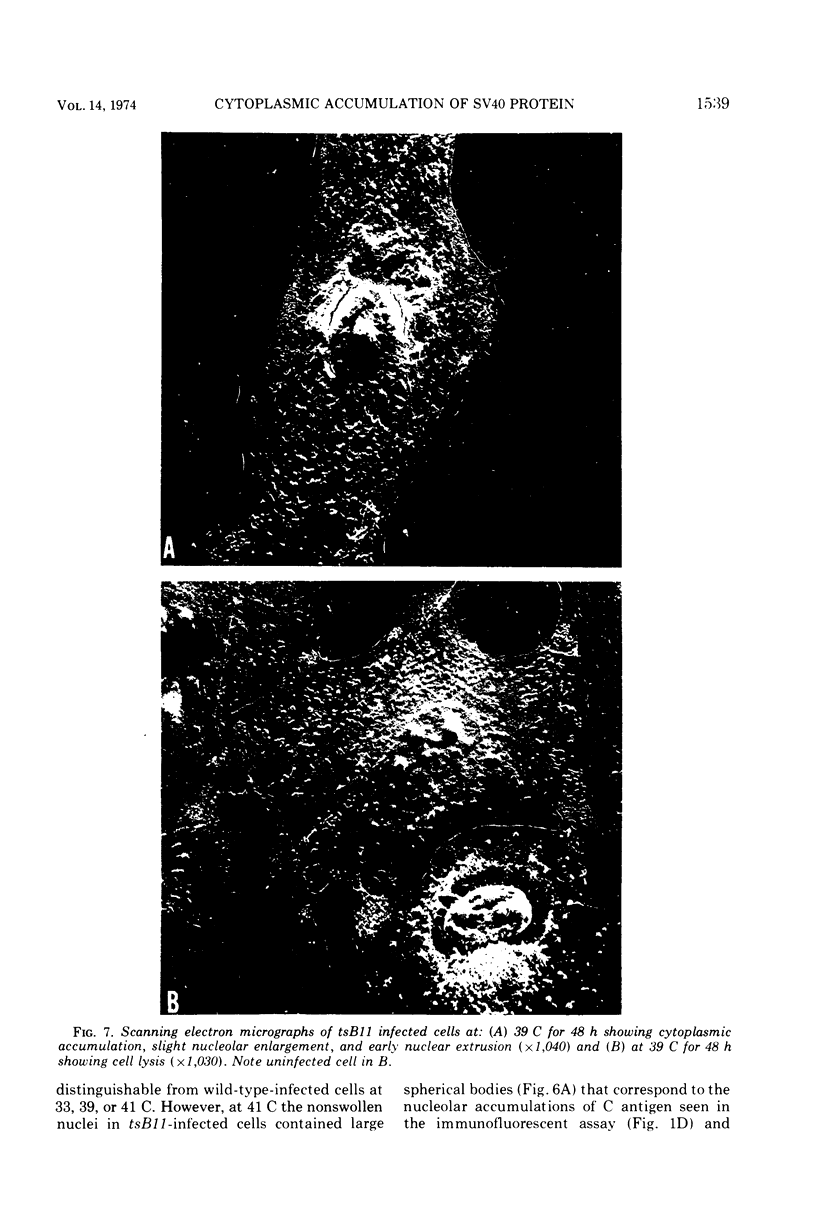
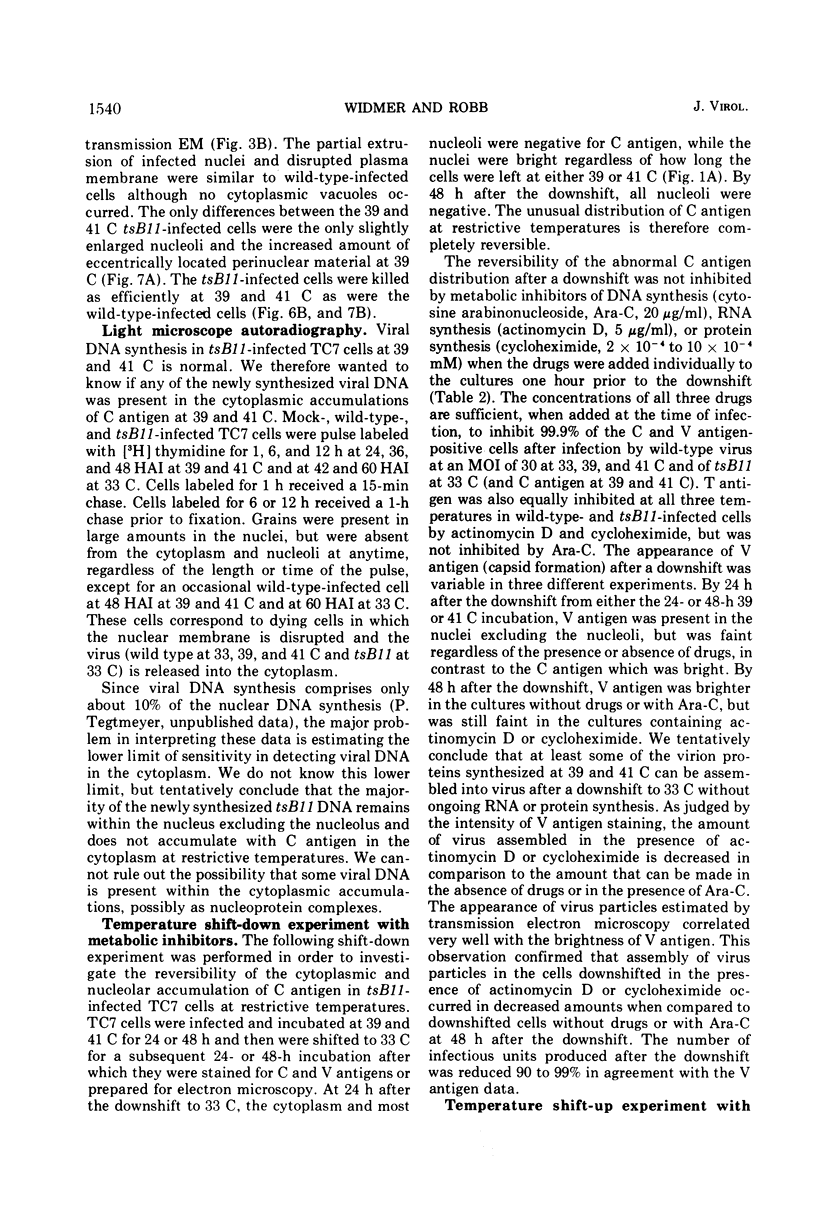
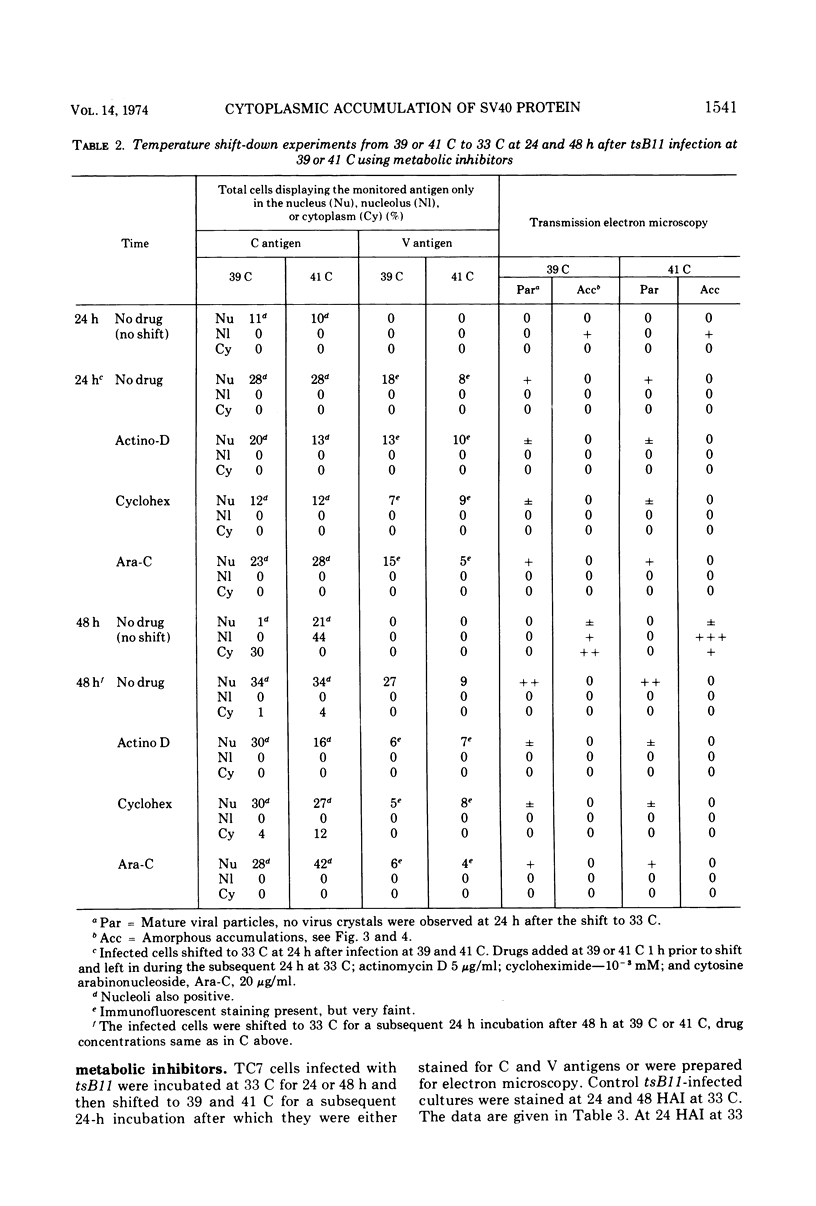
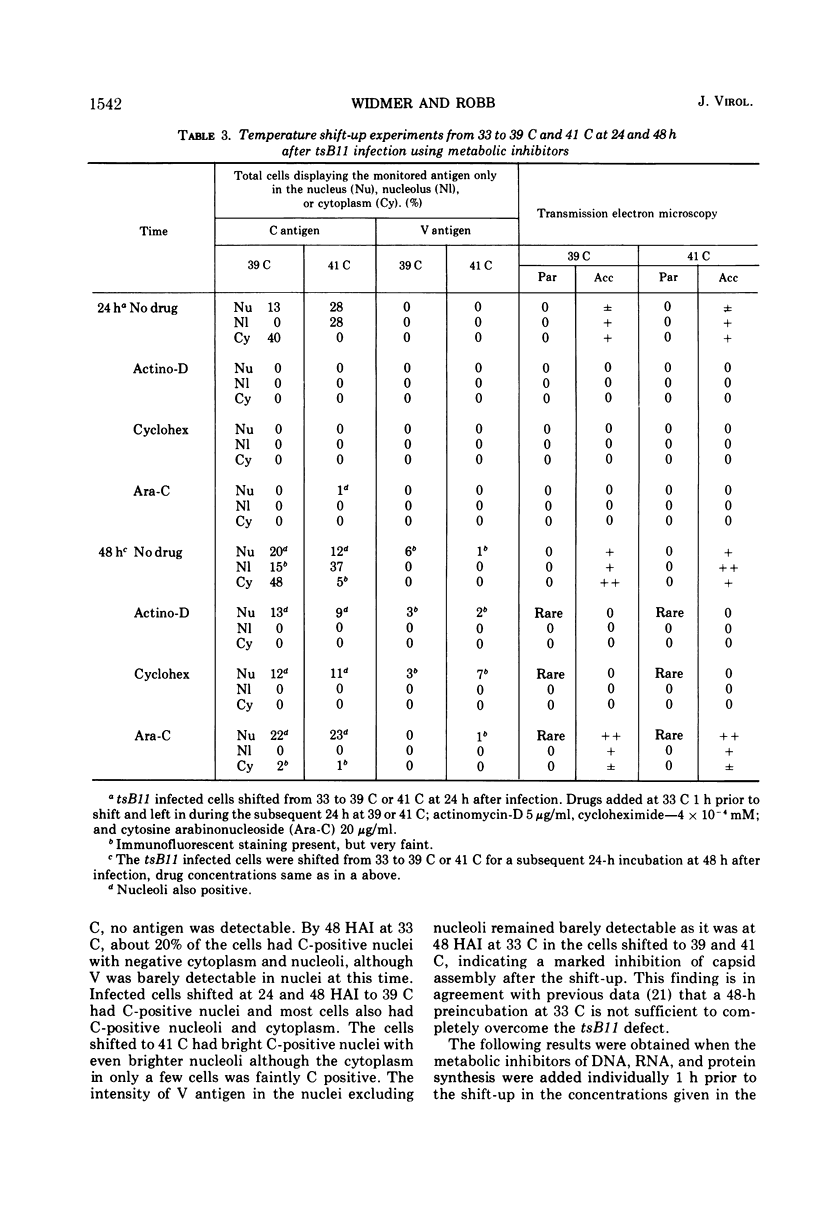
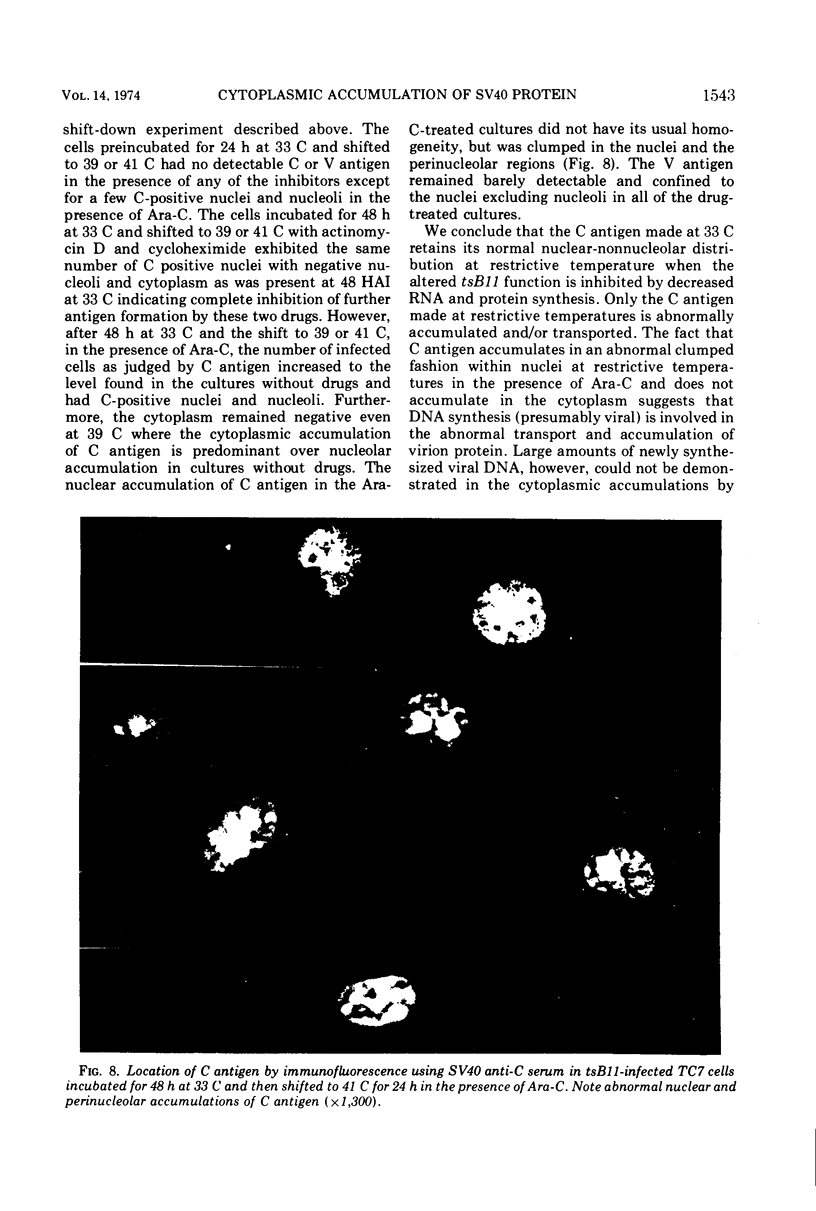
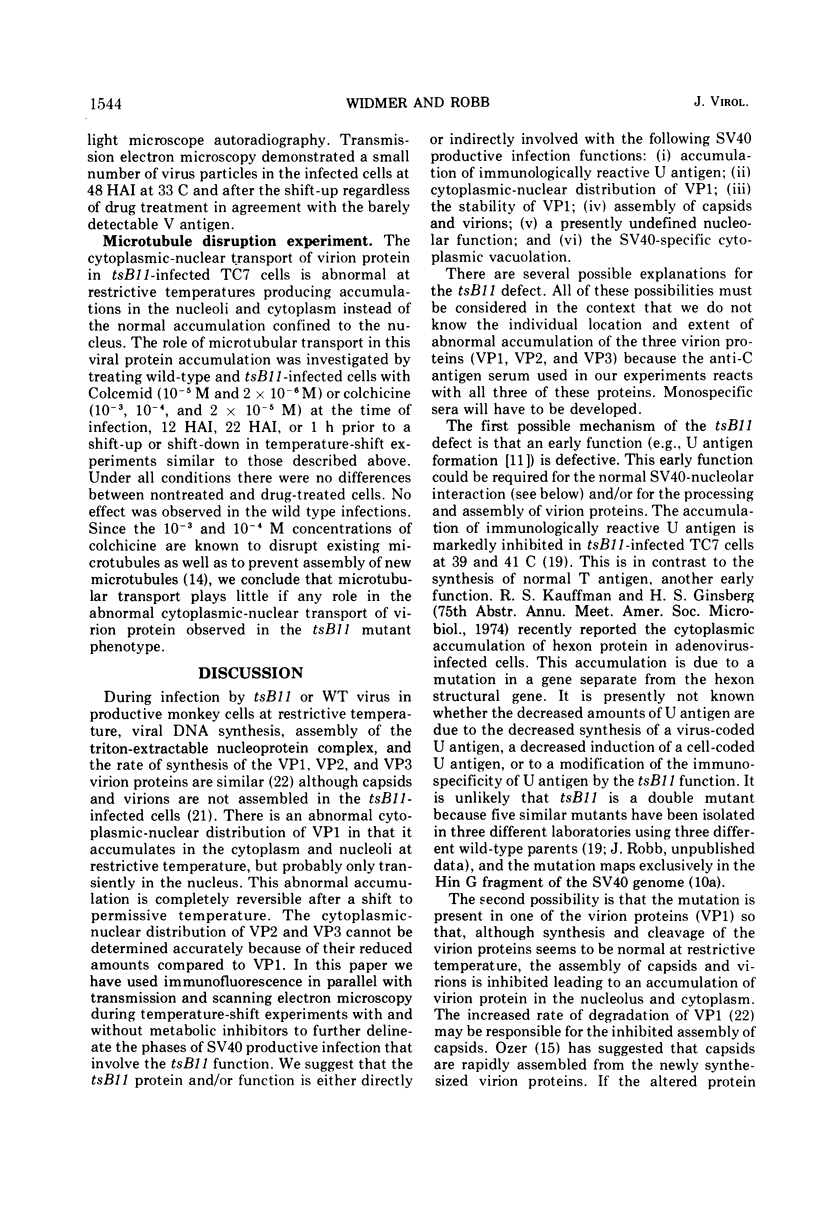
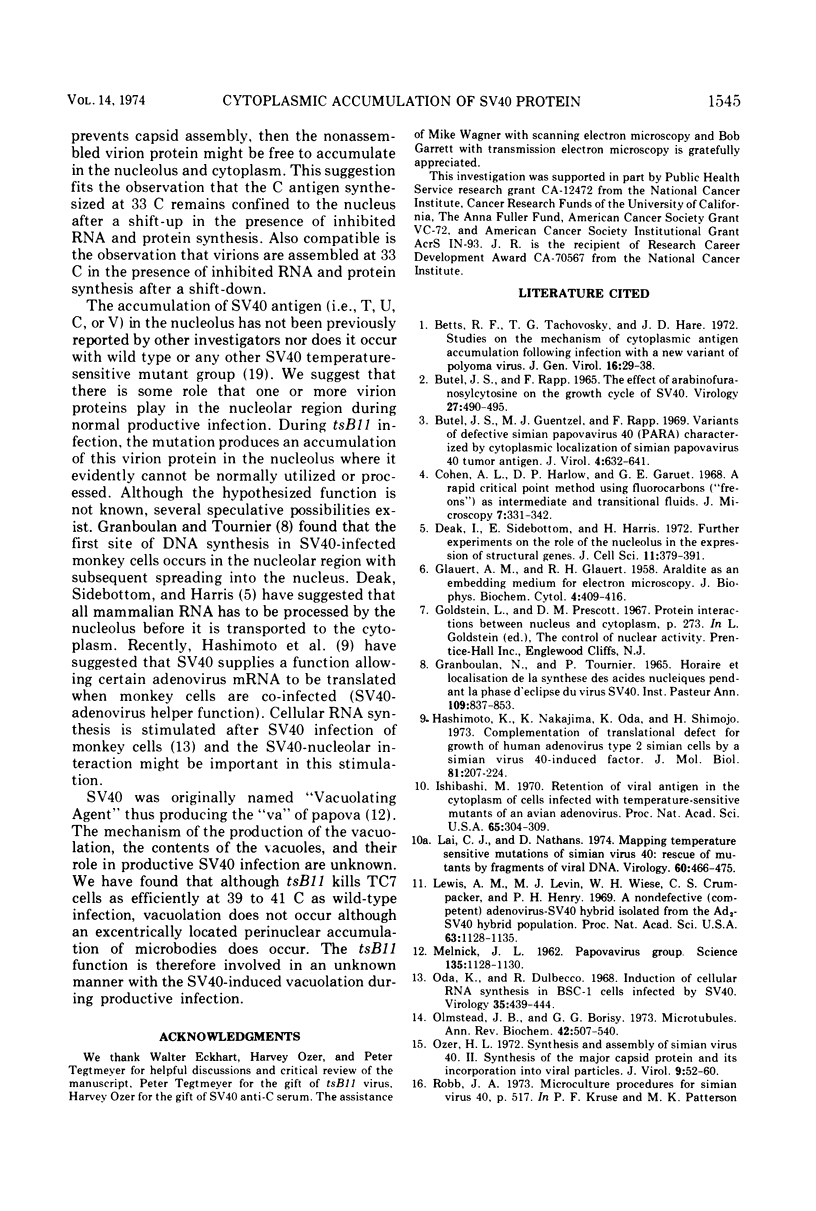
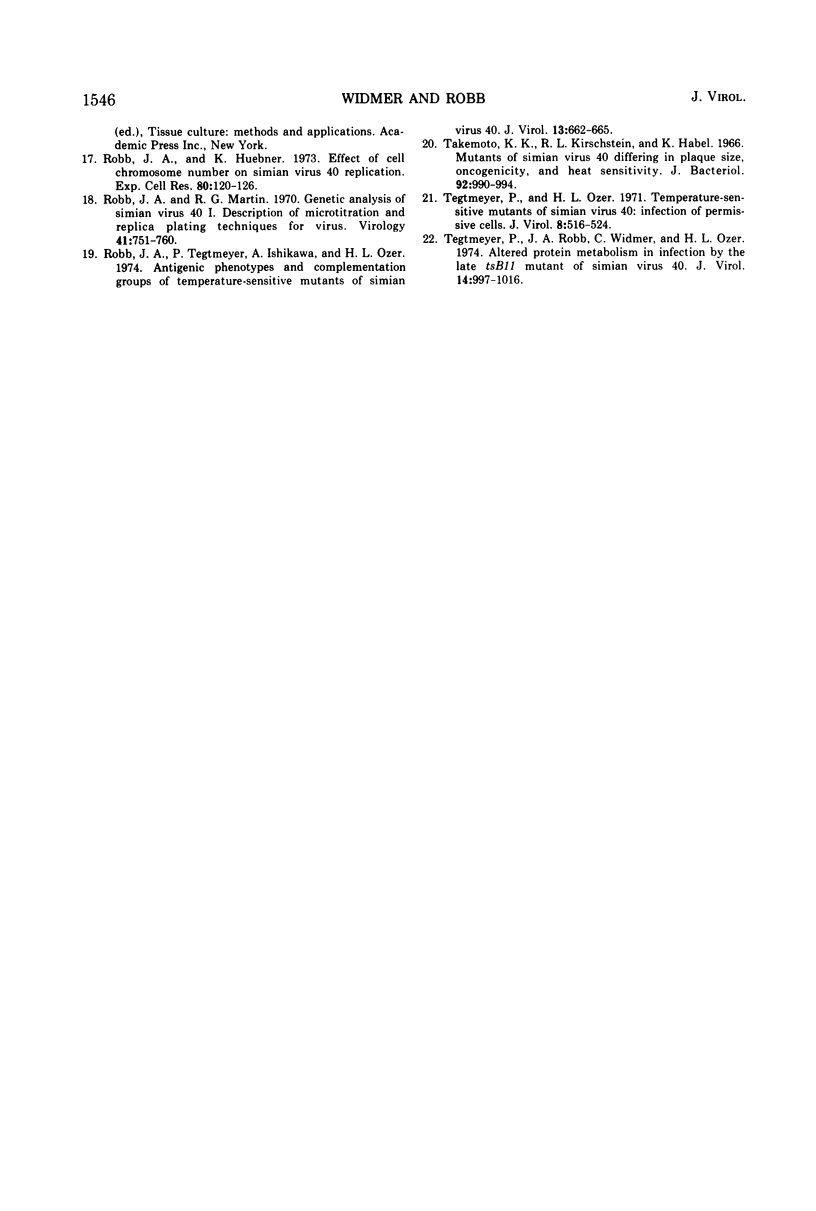
Images in this article
Selected References
These references are in PubMed. This may not be the complete list of references from this article.
- Betts R. F., Tachovsky T. G., Hare J. D. Studies on the mechanism of cytoplasmic antigen accumulation following infection with a new variant of polyoma virus. J Gen Virol. 1972 Jul;16(1):29–38. doi: 10.1099/0022-1317-16-1-29. [DOI] [PubMed] [Google Scholar]
- Butel J. S., Guentzel M. J., Rapp F. Variants of defective simian papovavirus 40 (PARA) characterized by cytoplasmic localization of simian papovavirus 40 tumor antigen. J Virol. 1969 Nov;4(5):632–641. doi: 10.1128/jvi.4.5.632-641.1969. [DOI] [PMC free article] [PubMed] [Google Scholar]
- Butel J. S., Rapp F. The effect of arabinofuranosylcytosine on the growth cycle of simian virus 40. Virology. 1965 Dec;27(4):490–495. doi: 10.1016/0042-6822(65)90174-1. [DOI] [PubMed] [Google Scholar]
- Deák I., Sidebottom E., Harris H. Further experiments on the role of the nucleolus in the expression of structural genes. J Cell Sci. 1972 Sep;11(2):379–391. doi: 10.1242/jcs.11.2.379. [DOI] [PubMed] [Google Scholar]
- Granboulan N., Tournier P. Horaire et localisation de la synthèse des acides nucléiques pendant la phase d'éclipse du virus SV40. Ann Inst Pasteur (Paris) 1965 Dec;109(6):837–854. [PubMed] [Google Scholar]
- Hashimoto K., Nakajima K., Oda K., Shimojo H. Complementation of translational defect for growth of human adenovirus type 2 in Simian cells by a Simian virus 40-induced factor. J Mol Biol. 1973 Dec 5;81(2):207–223. doi: 10.1016/0022-2836(73)90190-3. [DOI] [PubMed] [Google Scholar]
- Ishibashi M. Retention or viral antigen in the cytoplasm of cells infected with temperature-sensitive mutants of an avian adenovirus. Proc Natl Acad Sci U S A. 1970 Feb;65(2):304–309. doi: 10.1073/pnas.65.2.304. [DOI] [PMC free article] [PubMed] [Google Scholar]
- Lai C. J., Nathans D. Mapping temperature-sensitive mutants of simian virus 40: rescue of mutants by fragments of viral DNA. Virology. 1974 Aug;60(2):466–475. doi: 10.1016/0042-6822(74)90340-7. [DOI] [PubMed] [Google Scholar]
- Lewis A. M., Jr, Levin M. J., Wiese W. H., Crumpacker C. S., Henry P. H. A nondefective (competent) adenovirus-SV40 hybrid isolated from the AD.2-SV40 hybrid population. Proc Natl Acad Sci U S A. 1969 Aug;63(4):1128–1135. doi: 10.1073/pnas.63.4.1128. [DOI] [PMC free article] [PubMed] [Google Scholar]
- MELNICK J. L. Papova virus group. Science. 1962 Mar 30;135(3509):1128–1130. doi: 10.1126/science.135.3509.1128. [DOI] [PubMed] [Google Scholar]
- Oda K., Dulbecco R. Induction of cellular mRNA synthesis in BSC-1 cells infected by SV40. Virology. 1968 Jul;35(3):439–444. doi: 10.1016/0042-6822(68)90222-5. [DOI] [PubMed] [Google Scholar]
- Olmsted J. B., Borisy G. G. Microtubules. Annu Rev Biochem. 1973;42:507–540. doi: 10.1146/annurev.bi.42.070173.002451. [DOI] [PubMed] [Google Scholar]
- Ozer H. L., Tegtmeyer P. Synthesis and assembly of simian virus 40. II. Synthesis of the major capsid protein and its incorporation into viral particles. J Virol. 1972 Jan;9(1):52–60. doi: 10.1128/jvi.9.1.52-60.1972. [DOI] [PMC free article] [PubMed] [Google Scholar]
- Robb J. A., Huebner K. Effect of cell chromosome number on simian virus 40 replication. Exp Cell Res. 1973 Sep;81(1):120–126. doi: 10.1016/0014-4827(73)90118-3. [DOI] [PubMed] [Google Scholar]
- Robb J. A., Martin R. G. Genetic analysis of simian virus 40. I. Description of microtitration and replica-plating techniques for virus. Virology. 1970 Aug;41(4):751–760. doi: 10.1016/0042-6822(70)90439-3. [DOI] [PubMed] [Google Scholar]
- Robb J. A., Tegtmeyer P., Ishikawa A., Ozer H. L. Antigenic phenotypes and complementation groups of temperature-sensitive mutants of simian virus 40. J Virol. 1974 Mar;13(3):662–665. doi: 10.1128/jvi.13.3.662-665.1974. [DOI] [PMC free article] [PubMed] [Google Scholar]
- Takemoto K. K., Kirschstein R. L., Habel K. Mutants of simian virus 40 differing in plaque size, oncogenicity, and heat sensitivity. J Bacteriol. 1966 Oct;92(4):990–994. doi: 10.1128/jb.92.4.990-994.1966. [DOI] [PMC free article] [PubMed] [Google Scholar]
- Tegtmeyer P., Ozer H. L. Temperature-sensitive mutants of simian virus 40: infection of permissive cells. J Virol. 1971 Oct;8(4):516–524. doi: 10.1128/jvi.8.4.516-524.1971. [DOI] [PMC free article] [PubMed] [Google Scholar]
- Tegtmeyer P., Robb J. A., Widmer C., Ozer H. L. Altered protein metabolism in infection by the late tsB11 mutant of simian virus 40. J Virol. 1974 Oct;14(4):997–1007. doi: 10.1128/jvi.14.4.997-1007.1974. [DOI] [PMC free article] [PubMed] [Google Scholar]



